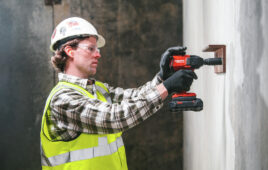Despite concerted efforts to reduce serious injuries on the job, workplace fatality rates in the United States have remained largely unchanged over the past three decades. To help reverse this devastating development and assist organizations on their safety journeys, the National Safety Council has released a new white paper through its Work to Zero initiative, related to Improving Workplace Safety with Robotics.
The new report builds on the Council’s Work to Zero‘s Safety Innovation Journey to help organizations assess risks, identify technology solutions, and ready workplaces for implementation.

Learn how technology can reduce the risk of workplace injuries here.
The new white paper, which analyzes academic journals, vendor interviews, and company case studies, evaluates the benefits of robotics and autonomous mobile robots, or AMRs, in reducing injuries and fatalities in the workplace. It also outlines best practices employers can follow to implement robotic technology across a range of workplaces.
“Robotics have long been deployed by organizations to improve operational efficiencies, but as companies increasingly look towards a more automated future, the many benefits this technology brings to workplace safety programs cannot be overlooked,” said Katherine Mendoza, senior director of workplace programs, NSC. “Recent advancements in data science and artificial intelligence mean that robotic vehicles and arms aren’t just capable of augmenting complex, precise tasks alongside human workers, but in many instances, can eliminate employees’ exposure to dangerous machinery and workplace hazards altogether.”
Mendoza added: “This report helps employers understand the various types of robots, their unique benefits and also some drawbacks, so they can more effectively integrate life-saving technology into their workplaces.”
For this white paper, Work to Zero identified the five most common robot configurations available to employers — AMRs, Automated Guided Vehicles or AGVs, Articulated Robots, Humanoid Robots, and Cobots — to assess their key benefits and applications.
In addition to concluding this technology can be ideal for manufacturing applications, where repetitive, high-volume production is necessary, the report identified several other examples in which employers can use robots to create safer outcomes for their workers, including:
- Inspecting confined spaces and industrial facilities. Organizations in the construction and manufacturing industries may especially benefit from using wheeled AMRs to remove human workers from on-site hazards.
- Transporting parts and materials. Used alongside sensors and computer vision, AMRs and AGVs can minimize the risk of human-machine collisions.
- Using robotic arms for precision cutting and welding, as well as the safe handling of toxic, high-temperature materials.
- Machine tending and parts repositioning by using robotic arms and AMRs to reduce risks associated with manual machine handling.
Work to Zero also found adopting robotic technology can help employers mitigate the risk of workplace musculoskeletal disorders, prevent falls, and reduce worker muscle fatigue.
However, several barriers to widespread robot adoption exist. While recent advancements have reduced the price and increased the viability of robotics for common industrial applications, costs of implementation and ongoing maintenance may still be prohibitive for smaller industrial operations.
Additionally, Work to Zero found AVG and AMR configurations may be disruptive to some work environments or need to be coupled with additional safety technologies to effectively mitigate risk. This underscores that, despite the many benefits, employers must tailor their robotic technology to meet their unique safety needs and drive the return on investment.
There’s also an enduring concern that robotics or other technology may eventually replace human workers, but the report noted that — in addition to robotics having the potential to improve efficiency and safety — increased automation can help businesses reduce costs overall. This can lead to increased investments and the creation of new jobs in other areas, especially in engineering, maintenance, and programming.
Ultimately, this white paper found the importance in having a proactive approach to addressing the potential consequences of automation, such as retraining and re-skilling programs for displaced workers, and ensuring the benefits of automation are shared equitably across organizations.









Tell Us What You Think!